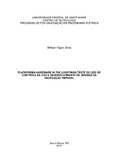| dc.creator | Silva, Willian Rigon | |
| dc.date.accessioned | 2018-10-15T21:38:08Z | |
| dc.date.available | 2018-10-15T21:38:08Z | |
| dc.date.issued | 2017-12-21 | |
| dc.identifier.uri | http://repositorio.ufsm.br/handle/1/14554 | |
| dc.description.abstract | The work presents a Hardware in The Loop (HIL) system design and construction, aimed
to test automatic flight control laws with the X-Plane flight simulator. In addition, the development,
integration, and tests of an Inertial Navigation System (AHRS/INS - Attitude and
Heading Reference System/Inertial Navigation System) is presented. The plant used in the
study is the Unmanned Aerial Vehicle (UAV) Half Scale (HS) of the Hórus Squadron, of the
Brazilian Air Force (FAB). The designed HIL system can be used to test the implementation
of the control laws in the flight computer, controlling the UAV model in the X-Plane. The
HIL test permits a quicker and safer automatic flight control law development. To show the
HIL system capabilities, results for several control laws are presented: Fly-By-Wire, Altitude
Hold Autopilot, and Mach Hold Autopilot. The UAV analytical model was constructed using
the classic longitudinal flight dynamics equations, with stability and control derivatives given
by USAF DATCOM. The control laws were designed with the classical control theory,
using the linearized model for the cruise flight phase. The longitudinal flight modes were
compared between the analytical model and the X-Plane model. With the objective to implement
the flight control laws in the real UAV, an inertial navigation system was developed
(AHRS/INS). The objective of the AHRS/INS system is to deliver the necessary flight information
to the control system. Static tests of the AHRS/INS system are shown, also it
is presented a methodology to calibrate magnetometers installed in aircraft. Concluding,
proposal for future works and HIL and AHRS/INS systems optimizations are presented. | eng |
| dc.language | por | por |
| dc.publisher | Universidade Federal de Santa Maria | por |
| dc.rights | Attribution-NonCommercial-NoDerivatives 4.0 International | * |
| dc.rights.uri | http://creativecommons.org/licenses/by-nc-nd/4.0/ | * |
| dc.subject | Modelagem | por |
| dc.subject | Simulação | por |
| dc.subject | Controle | por |
| dc.subject | Hardware-in-the-loop | por |
| dc.subject | Navegação inercial | por |
| dc.subject | Modelling | eng |
| dc.subject | Simulation | eng |
| dc.subject | Control | eng |
| dc.subject | Inertial navigation | eng |
| dc.title | Plataforma hardware in the loop para teste de leis de controle de voo e desenvolvimento de unidade de navegação inercial | por |
| dc.title.alternative | Hardware in the loop platform to test flight control laws and an inertial navigation system development | eng |
| dc.type | Dissertação | por |
| dc.description.resumo | O trabalho trata da concepção, construção e testes de um sistema para teste de leis de
controle de voo baseado em Hardware In The Loop (HIL). Além disso, é apresentado o
desenvolvimento, integração e testes de um sistema de navegação inercial (AHRS/INS -
Attitude and Heading Reference System/Inertial Navigation System). A planta escolhida
para o estudo é o Veículo Aéreo Não Tripulado (VANT) Meia Escala (Half Scale-HS), do
Esquadrão Hórus, da Força Aérea Brasileira (FAB). O sistema HIL desenvolvido permite
testar a implementação das leis de controle no computador de voo a ser embarcado, controlando
um modelo do VANT no simulador de voo X-Plane. Esse teste garante rapidez
e segurança no desenvolvimento de leis de controle de voo. São mostrados resultados
da implementação das malhas de controle Fly-By-Wire, Altitude Hold Autopilot e Mach
Hold Autopilot no sistema HIL. O modelo analítico do VANT foi concebido utilizando as
equações clássicas da dinâmica de voo, com derivadas de estabilidade e controle fornecidas
pelo USAF DATCOM. Somente a dinâmica longitudinal foi considerada. O projeto
das leis de controle foi realizado utilizando a teoria clássica, aplicado ao modelo analítico
linearizado para a fase de voo de cruzeiro. É mostrada uma comparação dos modos de
voo entre o modelo analítico e o modelo de simulador de voo X-Plane. Visando a implementação
das leis de controle no VANT real, foi desenvolvido um sistema AHRS/INS para
fornecer os dados necessários para o sistema de controle. Testes estáticos do sistema
AHRS/INS instalado no VANT HS são apresentados, assim como uma metodologia para
calibração de magnetômetros em aviões e VANTs. Ao final são apresentadas sugestões
para trabalhos futuros e otimizações dos sistemas HIL e AHRS/INS. | por |
| dc.contributor.advisor1 | Gründling, Hilton Abílio | |
| dc.contributor.advisor1Lattes | http://lattes.cnpq.br/6128096609162437 | por |
| dc.contributor.advisor-co1 | Silva, André Luís da | |
| dc.contributor.advisor-co1Lattes | http://lattes.cnpq.br/5249665241981260 | por |
| dc.contributor.referee1 | Paglione, Pedro | |
| dc.contributor.referee1Lattes | http://lattes.cnpq.br/7315358137176715 | por |
| dc.contributor.referee2 | Waschburger, Ronaldo | |
| dc.contributor.referee2Lattes | http://lattes.cnpq.br/3651342699085197 | por |
| dc.creator.Lattes | http://lattes.cnpq.br/0357949175676885 | por |
| dc.publisher.country | Brasil | por |
| dc.publisher.department | Engenharia Elétrica | por |
| dc.publisher.initials | UFSM | por |
| dc.publisher.program | Programa de Pós-Graduação em Engenharia Elétrica | por |
| dc.subject.cnpq | CNPQ::ENGENHARIAS::ENGENHARIA ELETRICA | por |
| dc.publisher.unidade | Centro de Tecnologia | por |



